Disclaimer: This article includes affiliate links. If you choose to purchase any of the products we have discussed in this article, we may receive a small, and much appreciated commission.
How do you choose a flashlight? It is a cliche statement to make, but while there are many great options there is really no one best flashlight for all purposes. Purpose, performance, convenience, etc. all factor into your decision. This guide will help determine what criteria you should be looking for when making a purchase decision for a quality flashlight.
How Are You Going to Use Your Flashlight?
Flashlights started out as a novelty and niche item, but have grown into indispensable tools today. Nobody can predict all of the uses you will need your flashlight for. But if you apply the 80/20 rule you can narrow down to some options that will serve you well most of the time. Consider these common purposes when making your buying decision.
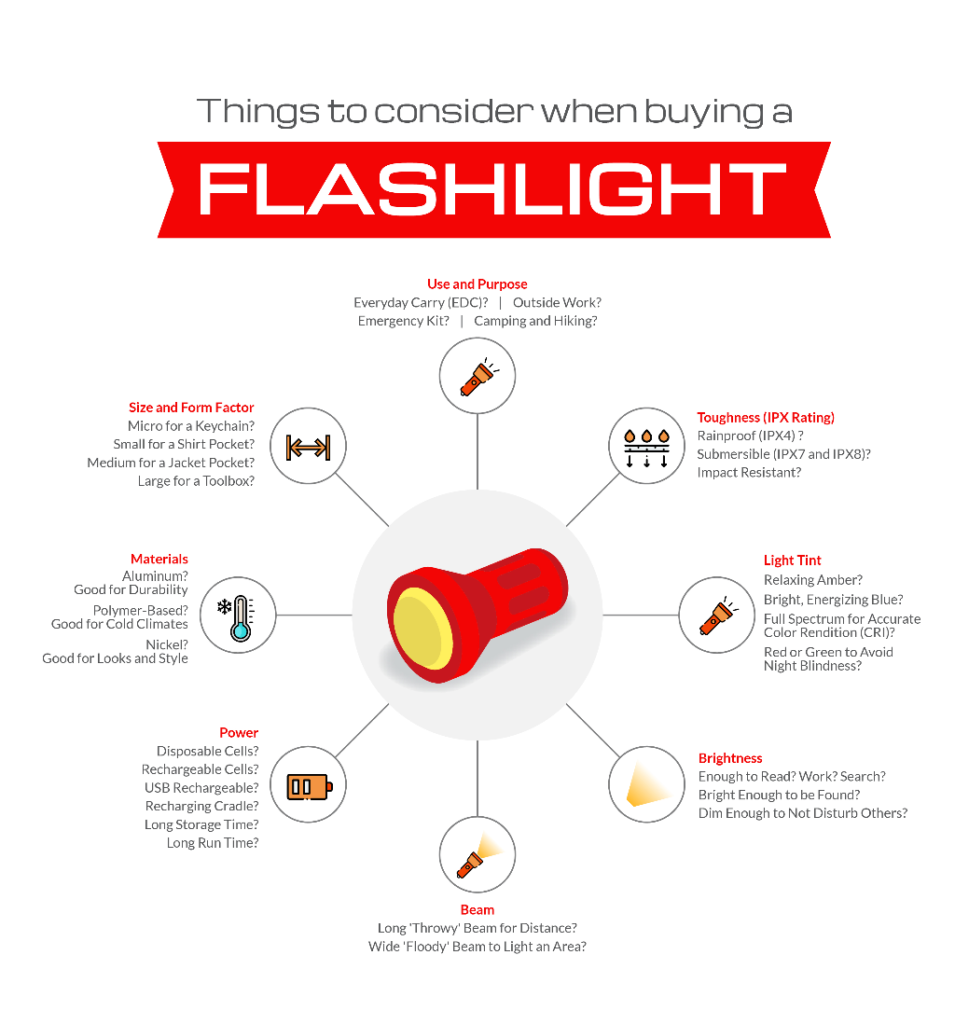
General Purpose
I have fond memories of using my parent’s yellow plastic Rayovac flashlight as a lightsaber while walking the dog. This is the flashlight you have in your drawer by the nightstand or the ‘junk drawer’ or your garage. It is handy and let’s you throw a light on a subject. Size and performance is not a factor as long as it can fit in the drawer.
Everyday Carry – EDC
EDC is shorthand for Everyday Carry. These flashlights are small and always on your person. Some fit the category of pocket or pen lights, while others qualify for small tactical flashlights. My dad used to carry a small light that looked just like a pen in his shirt pocket. Consider how you want to carry your light (in your slacks pocket, on a belt holster, etc) and how you are going to power it (replaceable cells? USB chargeable?, etc.)
Work
Work lights are centric to a location such as a garage, warehouse, or a vehicle. They are usually bright and durable, and conveniently located on a wall mounted or base station charger so they are always ready to go.
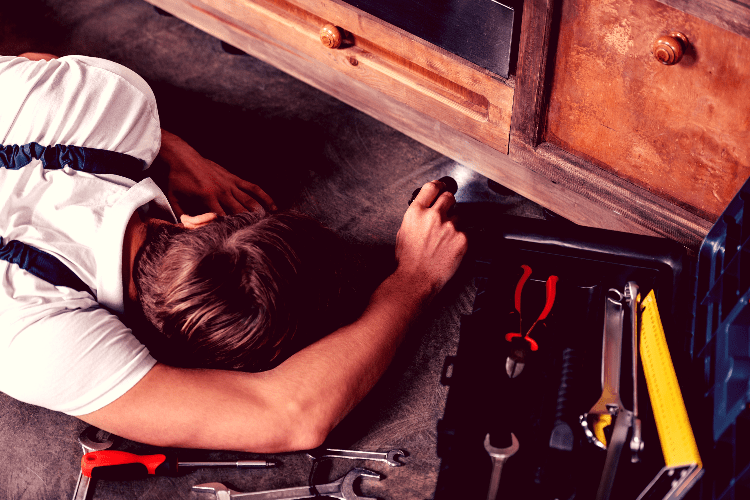
Outdoor Recreation
This includes free-standing camping lanterns, or other lights that have convenient features such as the ability to hang from an overhead branch or rope. I often think of my dad’s old green Coleman lantern I used for reading while camping in the tent.
Searching
Maximum brightness and throw are the hallmarks of a good Search light. My uncle used to have an old 12 volt ‘square battery’ search light we would chase each other around the woods with or use to find our dog that wandered off. Nowadays the LED lights used for searching are way brighter by comparison, with some throwing light over one kilometer. Size is not a factor in these lights – bigger is typically brighter.
Marine
Very similar to General or Working lights in that the task at hand defines the features of your light. Marine lights are also completely waterproof for use in a marine environment. Some can even float.
Search and Rescue is a role that every boat must be ready to undertake, and seconds count in northern waters. Having a powerful search light at hand can truly mean the difference between life and death.
Emergency Use
Natural Disasters happen without warning. Often breaking down all of our comfort and safety systems such as power and heat. Disaster affected my family as far back as the 1964 earthquake here in Alaska. Recent hurricane disasters have affected millions. Manual power cranks can help keep your flashlight charged through a prolonged power outage. Radios, signal lights and durability are the hallmarks of a good emergency use light.
Tactical – Self Defense
You never know when you will have an encounter that threatens yourself or your loved ones, or what situation will look like. Being ready for such an encounter covers a lot of ground. There are many that have the opinion that having a ‘tactical’ flashlight at the ready will give you an advantage.
My uncle used to carry a 6 ‘D’ cell Mag Light. He would sometimes carry it over his shoulder by his cheek so he could use it as a club when he felt he needed too – much like a police officer on a traffic stop.
Modern flashlights are much smaller and brighter than before. The idea of blinding or disorienting an assailant instead of clubbing them is now a popular technique. Brightness (1000 Lumens or more) candela (directional brightness) and size are the critical factors.
Weatherproofing and ease of use (such as an instant-on tail switch) are also important.
We suggest that you research, seek training, and really know what you are doing before relying on any piece of equipment for such a situation.
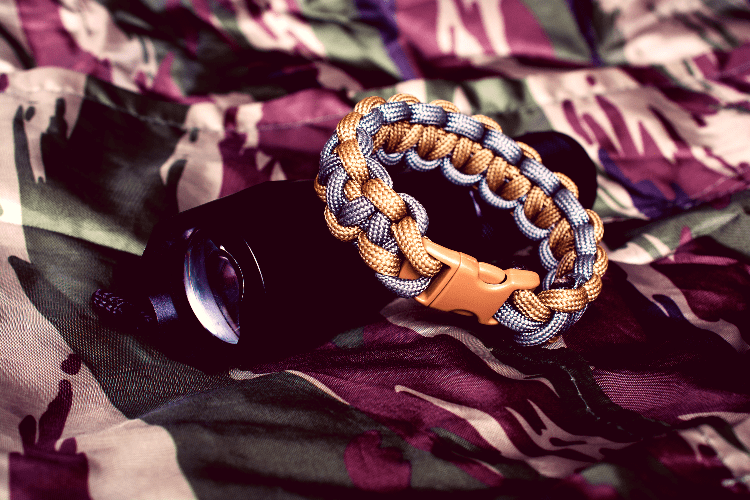
Hands Free
Headlamps are a great option for personal illumination that still allows you to work and use your hands. Lightweight campers, hikers and other outdoor enthusiasts do love their headlamps. Fit and comfort are the key here, as well as longevity for multi-day trips. Having the ability to go below 10 Lumens for times you don’t want to blow yours or everyone else’s night vision is valuable.
Flashlight Bulb Types
Bulbs fall into two main categories – Incandescent and LED
Incandescent Bulb
Incandescent bulbs shine by heating a metal filament with an electric current. This actually produces more heat than it does light. Incandescent bulbs typically produce a warm, orangish light that is more pleasing to the eye than the cooler, blue LED lights common today.
If you are in the market for a flashlight you can still find one with an incandescent bulb and the warmer light is a great reason to choose one.
LED Lamp
LED’s, or Light Emitting Diodes, has become the de-facto standard for handheld flashlights. LED’s are cheap to make and are much more efficient on power and are extremely bright compared to comparable Incandescent bulbs. They also put off less heat when compared to incandescent bulbs. LEDs produce a cool, bluish light that is great for lighting up a scene. But they can wreak havoc on night vision, and even interrupt circadian rhythms and sleep patterns if used before bed. Higher quality LED flashlights can be found with a ‘neutral white’ or ‘warm white’ option which is helps to reduce these effects.
Flashlight Batteries and Run Time
The ANSI FL1 standard identifies Run Time as the amount of time it takes a flashlight to drop to 10% of it’s maximum output using the manufacturers recommended batteries. It is the point where you need to recharge your batteries or replace them.
Primary Cell
Primary Cells are non-rechargeable, replaceable batteries. They allow for almost constant run time for your flashlight as long as you have fresh replacements. These can be expensive and the costs can rack up over time. Discharged primary cells are also very harmful to the environment.
They are typically Alkaline batteries and come in the standard sizes you are used too such as ‘AAA’, ‘AA’, ‘C’ and ‘D’. There are standard sized Lithium batteries such as the CR123A, but you can also find them in ‘AAA’ or ‘AA’ sizes.
Rechargeable Cell
Rechargeable cells can be recharged hundreds or thousands of times. This reduces both cost and the harmful battery footprint on the environment. Many also have capacities and voltages greater than Alkaline cells.
When the Rechargeable Cell is integrated into the battery your flashlight is out of commission until it is recharged. This may be acceptable depending on your needs and the flashlight runtime. Replaceable cells allow for Rechargeable Cells to be swapped out with fresh ones and extend your run time.
Learn everything you need to know about Batteries with our Ultimate Guide to Batteries!
Weatherproofing and Durability
The IP Code – defined as either International Protection Marking or Ingress Protection Marking. It is an International Electrotechnical Commission (IEC) standard which measures the degree of protection a case has against dust, water or other objects. The rating is written as “IP(a)(b)” where the ‘a’ rating is a numeric indicator of dust resistance and the ‘b’ rating is a numeric indicator of water resistance.
The waterproof rating is the most important In flashlights and you will commonly see the dust rating ignored or indicated simply by an ‘X’ (ex: IPX4).
The waterproof ratings are 0 – 9, with higher numbers being more effective. Here are the common ratings you will see in flashlights and what they mean:
- IPX0 – No water protection at all
- IPX4 – Splash protection – protects from spraying water from any direction (rainproof).
- IPX7 – Immersion up to 1 meter for 30 minutes
- IPX8 – Immersion of more than 1 meter, with depth and time specified by the manufacturer
Sometimes the manufacturer doesn’t give the number, only graphics like these below. These images typically indicate ratings including IPX4 (rainproof) and IPX7 or IPX8 (submersible)
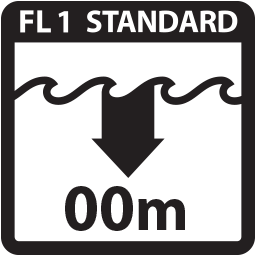 | ANSI Water Submersion Rating |
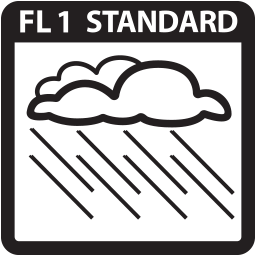 | ANSI Water Resistance Rating |
How durable is it? What does IPX6 mean? Read our Ultimate Guide to the ANSI/PLATO FL1 Standard symbols!
Size and Convenience
In photography they say the best camera you can use is the one that you have with you. It is much the same with flashlights. Consider these common form factors when evaluating the convenience of a flashlight.
Keychain
If you are always having an issue finding a keyhole, having a light on your keychain is most helpful. Small size and the ability to easily disconnect from the key ring are the main considerations.
Which pocket are you going to fit it in? I sometimes work in an office so a long, slender light with a pocket clip works best. When I’m outside or camping I can use a pocket flashlight that is a little bigger, but I don’t like one over 1 inch in diameter. Construction workers, first responders or others with bigger pockets may feel more comfortable with larger and higher performing lights.
Medium Handheld
These are your general purpose, tactical and searchlight flashlights. Along with selecting the right flashlight for your needs, performance and reliability are the most important considerations.
Headlamp
A headlamp allows for a lot of illumination of your personal space while keeping your hands free. Many headlamps are self-contained units, with the battery in front with the light. While some higher performance models may have a battery pack attached either on the back of the head strap or attached via some other method. This may affect the comfort level of the headlamp.
Lantern
Lanterns allow for hands-free illumination of a space such as a table, tent or other type of room or workspace. They typically have a cover that spreads the light out evenly in the space. They are great for camping and working on projects.
Check out our Best Flashlight Guides library to find the perfect flashlight for your needs:
- Best Rechargeable Flashlights under $50
- Best Flashlights under $100
- Best Flashlight Brands
- Best Magnetic Flashlights
- Best Waterproof Flashlights
- Best 90 Degree Flashlights
- Best Keychain Flashlights
- Best Compact Flashlights
- Best Handheld Flashlights
- Best Penlight Flashlights
- Best Small Flashlights
- Best Pocket Flashlights
Flashlight Beam
Will you be searching in the woods or using the flashlight under a car hood? The shape of the beam put out by a flashlight is an often overlooked feature that can make a big difference in how useful a flashlight is for you.
Narrow Beams
Spotlights or ‘narrow beam’ lights focus on beam distance or ‘throw’. The width of the beam will be small and may not light up much around your target or close to you. Narrow Beam flashlights typically have a very smooth reflector to focus the light into a tighter direction. This allows for illumination a great distance away.
Wide Beams
Area or ‘wide beam’ flashlights are generally softer and can light up a room or an area well. Reflectors for wide beam flashlights have an ‘orange peel’ texture to provide maximum light scatter.
A wide beam flashlight is superior to a narrow beam for situational awareness of your surroundings. This area lighting is also more appropriate for working on a project, fixing a vehicle, etc. but is not well suited for lighting subjects up at a distance.
Adjustable Beams
Some flashlights offer a focusing ring to adjust the beam from between Area and Spotlight configurations. This may sound like you get the best of both worlds, but most quality flashlights seem to go with either one or the other.
Brightness
Brightness is not everything in a flashlight. However, if your flashlight is not bright enough for your needs then it will not work for you. Manufacturers have been touting Lumens as the end-all measurement to go by, but there is much more to the story. More Lumens is not always better and it may not be the appropriate stat to look for depending on your purpose.
Lumens
Lumens is the measurement of overall light output, or how much visible light is produced by the light source. This does not take into account the direction or any focusing of the light by a reflector. For illustration, the standard 60w bulb in your ceiling light fixture has about 800 Lumens. Lumens is a key measurement when looking for a camping lantern or other wide-beam/omnidirectional light source.
Candela
Candela (or candlepower) is a measurement of light output or luminous power in a single direction from the light source. Basically the intensity of the beam. This is usually measured around the center (or hotspot) of the beam. Candela is a key measurement when shopping for narrow beam flashlights like searchlights. A low candela means the beam is well diffused, especially if it has high Lumens.
Beam Distance
Our Lumens, Lux, and Candela article is a great resource to learn more about Lumens and light output
Beam Distance (or ‘Throw’) is the distance your light can travel and still light up an area. When you add a smooth parabolic reflector to a high Lumen LED lamp you direct much of the light output into a single direction. This can light up objects a great distance away – sometimes a kilometer or more. Naturally this is important for searchlights or other narrow-beam applications.
Modes
Many flashlights have a single brightness level – On and Off. Others have a number of brightness modes going from Low to High to Brighter Than The Sun. Multi-mode flashlights offer more flexibility. Single mode lights offer simplicity.
Color Temperature
Do not underestimate the value of having the correct Color Temperature. Color Temperature is measured in Kelvin (K), ranging from 3000K to 6500K or more, and affects brightness, mood, sleep and light blindness.
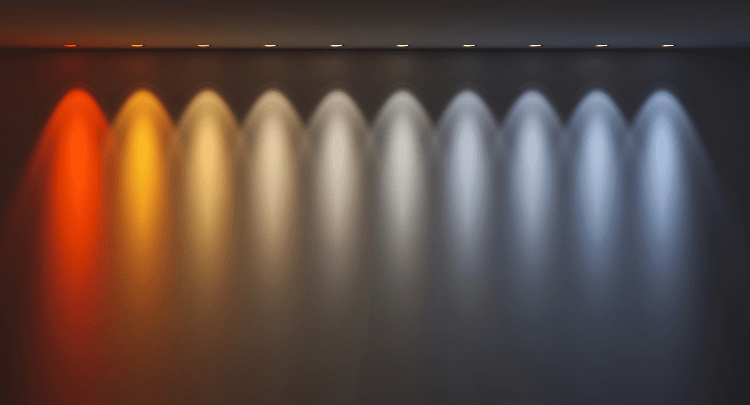
Warm White
Humans evolved over tens of thousands of years to end their day with an amber colored campfire. Gas lamps and incandescent bulbs coincidentally mimicked this color as time and technology rolled on. This is the color temperature range referred to as Warm White, and measures 2000K – 3000K.
Cool White
Daylight and blue skies have had a wakening effect on the human body in the same way that campfires have a calming one. This type of light is in the 4600K-6500K range and called Cool White due to its’ bluish tint.
Cool White bulbs give off a bluish tint which has higher scatter and is brighter than Warm White. They can be hard on the eyes and disturb circadian rhythms.
Neutral White
Neutral White is a compromise that sits right in the middle at 3100K-4500K. It has much of the apparent brightness of a cool white while retaining some of the amber color of the warm white. It will still disrupt circadian rhythms but is not as harsh on the eyes.
Read our Ultimate Guide to Flashlight Tint to learn all about how important Flashlight Color Tints are.
Specialty Colors
Many higher-end flashlights have lenses or integrated bulbs that provide specialty light colors. These are used for different purposes, but almost all of them help to retain night vision.
Red Light is easy on the eyes. It’s a good after-bedtime light for reading or finding your way to the outhouse. Having an integrated Red Light is one of my favorite features to look for in any flashlight because I love to read at night. Red Light has little color differentiation. Maps and any other diagrams where red is used a lot are particularly difficult to read under a Red Light.
Green and Blue Lights are generally recommended for hunting. Both are better at reading maps than a Red Light. It is believed that Green Light doesn’t spook game, and Blue Light is useful for following a blood trail at night.
Materials
Many would say that plastic is cheap and metal is higher quality and leave it at that. But if you dig deeper you will see that there are definitely reasons to choose a polymer casing over a metal one in a flashlight.
Metal Casings
It’s easy to think that LED lights do not generate heat, but that is not the case. High power LED’s can actually generate quite a lot of heat which is damaging to the lifespan of the LED emitter. A metal casing like aircraft-grade aluminum is often used to help dissipate that heat quickly.
The milling process also allows for much smaller flashlights than with plastics. A metal case does show wear and tear much more prominently than with a plastic casing
Plastic Polymers
Plastic polymers are thermal insulators and can be more easily handled in cold climates. They non-conductive and cannot transfer heat away from the light emitter so are not used very often with today’s high output LED’s. Plastic casings take abuse well are great for cooler running, medium size flashlights.
Additional Features
Flashlight manufacturers are always innovating and adding features to differentiate their products from the rest of the market. Some of these features are very useful depending on your needs. Here are a few features you may come across.
Lockout switch – Having your light turn on in your bag and draining the batteries is a common issue and can be a real problem on a longer hiking or hunting trip. Lockout switches prevent this from occurring.
Magnetic Base/End Standing – A magnetic base is great for attaching your light somewhere to light your workspace and free your hands. This is especially useful for smaller EDC or Pocket lights. Standing a flashlight on its’ end to light the ceiling is a cheap way to add indirect light to a room.
Non-rolling bezel – A hex shaped bezel will help keep your otherwise sleek and smooth flashlight from rolling under the couch.
Strike bezel – if you want to hit someone with your flashlight, this will do more damage.
Strobe Mode – Used for signaling or disorienting someone in a self-defense situation.
Laser – Great for leading a presentation, long distance signaling or teasing the cat.
Radio/Siren – Additional considerations for survival lights.
Conclusion
Buying a quality flashlight is not as simple as grabbing one off of the department store shelf. Primary Cells or Rechargeable, Size and Weight, Weatherproofing and Durability, Metal vs Plastic, etc. are all important considerations.
Now that you have a handle on How to Select the Best Flashlight for You, here are some other articles on our site to review:
Click here to see the Best Flashlight Brands reviewed!
